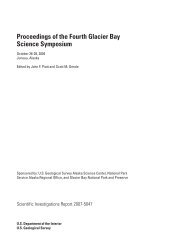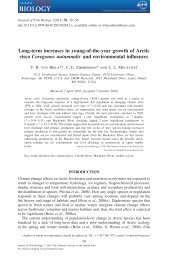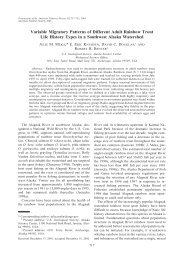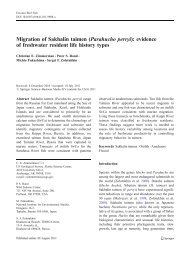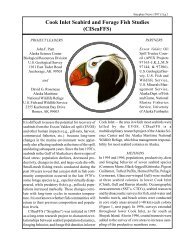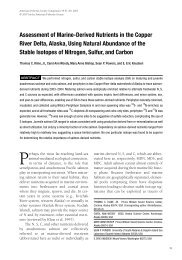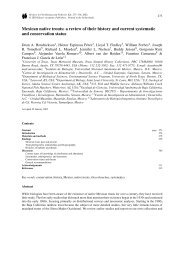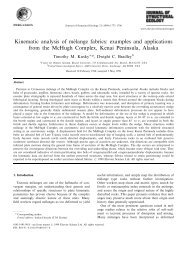UNCORRECTED PAGE PROOFS - USGS Alaska Science Center
UNCORRECTED PAGE PROOFS - USGS Alaska Science Center
UNCORRECTED PAGE PROOFS - USGS Alaska Science Center
Create successful ePaper yourself
Turn your PDF publications into a flip-book with our unique Google optimized e-Paper software.
spe371-01 page 27 of 31<br />
Geologic signature of early Tertiary ridge subduction in <strong>Alaska</strong> 27<br />
along a convergent margin, several mechanical effects might be<br />
expected in an accretionary prism. One effect is simply topographic:<br />
At 2.7 km below sea level, a spreading ridge is a highstanding,<br />
buoyant object rising far above normal ocean ßoor. The<br />
trench would be expected to shallow, then deepen, as a subducting<br />
ridge passes a particular location (DeLong and Fox, 1977).<br />
This effect can be seen in the Chile Trench, which systematically<br />
shallows toward the Chile triple junction (e.g., Thornburg and<br />
Kulm, 1987, their Fig. 2). Judging from the Chilean example,<br />
the bathymetric anomaly associated with the subducting ridge<br />
in <strong>Alaska</strong> could have been perhaps 3 km high and several<br />
thousand kilometers long. Geologic conÞrmation of this longwavelength<br />
effect has not been speciÞcally sought in <strong>Alaska</strong>, but<br />
anecdotal observations are at least consistent with what might be<br />
expected. Rise of the accretionary prism above sea level during<br />
late Paleocene or Eocene is recorded by detritus shed landward<br />
into the forearc basin (Little and Naeser, 1989). The paleocurrent<br />
patterns of turbidites deposited along or near the continental<br />
margin show a profound change at about the time of near-trench<br />
magmatism, which could have been due to bathymetric changes<br />
associated with the passage of the triple junction.<br />
On a shorter wavelength, the subducting ridge crest itself<br />
is likely to induce shortening and uplift in the immediate vicinity<br />
of the triple junction. At the Chile triple junction, the ridge<br />
indents the inner trench wall (Forsythe and Prior, 1992), and a<br />
similar effect can be seen elsewhere in the world where aseismic<br />
ridges are presently being subducted (e.g., Cocos Ridge<br />
at the Middle American Trench; Corrigan et al., 1990). The<br />
structural evidence summarized above shows that margin-perpendicular<br />
shortening did take place in the accretionary prism<br />
at the time of ridge subduction in <strong>Alaska</strong>.<br />
Another likely effect of ridge subduction involves a weakening<br />
of the accretionary prism as a result of heating, both<br />
advectively by rising magmas and conductively from hot asthenosphere<br />
of the slab window. The fact that the Chugach–Prince<br />
William accretionary prism was heated is self-evident from the<br />
extent of near-trench plutons (Fig. 2) and of areas of mid-greenschist<br />
and higher metamorphism (Fig. 13). In the Chugach metamorphic<br />
complex, D2 recumbent folds that Pavlis and Sisson<br />
(1995) attributed to vertical shortening might be attributed to a<br />
loss of strength of the prism. There is no evidence that the weakened<br />
prism extended in a seaward direction, but it did extend parallel<br />
to the margin in areas of both ductile and brittle deformation<br />
(Fig. 16). Eventually, as the triple junction moved on, it would<br />
have left in its wake an accretionary prism that cooled with time.<br />
The Þnal outcome of ridge subduction in <strong>Alaska</strong> was an accretionary<br />
prism that was riddled with isotropic plutons armored<br />
by hornfels rims, undoubtedly stronger—and hence capable of<br />
sustaining a steeper critical taper—than before.<br />
Magmatism Related to Ridge Subduction<br />
<strong>UNCORRECTED</strong> <strong>PAGE</strong> <strong>PROOFS</strong><br />
Five igneous provinces in <strong>Alaska</strong> can be temporally linked<br />
to ridge subduction (Fig. 16B). The following list starts at the<br />
seaward end of a north-south transect in the vicinity of the oroclinal<br />
axis: (1) pillow basalts and andesites that are interbedded<br />
with trench deposits; (2) the near-trench plutons and dikes that<br />
are the main basis for the ridge-subduction model; (3) volcanics<br />
in the forearc basin; (4) the youngest plutons along the arc axis<br />
in the <strong>Alaska</strong> Range that predate a magmatic lull of about 15<br />
million years; and (5) widespread volcanics in a continental<br />
backarc region. Each of these has potential analogues in the<br />
modern world.<br />
The Knight Island and Resurrection Peninsula ophiolites<br />
are presumed to be analogous to ocean ßoor that is presently<br />
being produced at spreading centers that are about to be subducted,<br />
such as the Chile Rise and the Gorda Ridge. Sheeted<br />
dike complexes attest to an extensional tectonic setting. Interbedded<br />
turbidites within the pillow sequence suggest proximity<br />
to a trench. Trace-element data can be explained by sediment<br />
contamination of N-MORB-like magmas to yield arc-like trace<br />
element signatures (Crowe et al., 1992; Nelson and Nelson,<br />
1993; Lytwyn et al., 1997). Off-axis igneous activity in the<br />
trench is perhaps represented by basaltic and andesitic ßows<br />
that are interbedded with ßysch sequences and are not associated<br />
with sheeted dike complexes. Such anomalous volcanism<br />
on the downgoing plate is the hallmark feature of ridge subduction<br />
east of New Guinea, where the Woodlark spreading center<br />
has encountered the Solomon Trench (Taylor and Exon, 1987).<br />
The near-trench intrusive rocks provide the strongest evidence<br />
for ridge subduction. Trace-element and isotopic data are<br />
best interpreted in terms of melting of ßysch at depth in the<br />
accretionary prism, the heat having been supplied by upwelling<br />
asthenosphere in the slab window. The forearc volcanoes<br />
shown in Figure 15 would be the extrusive equivalents of intrusive<br />
rocks seen today at the present level of exposure. Modern<br />
analogues are known from the Woodlark triple junction, where<br />
active volcanoes dot the trench and forearc (Taylor and Exon,<br />
1987), and the Chile triple junction, where a near-trench granodiorite<br />
pluton has been dated at 3.6 Ma (Forsythe and Nelson,<br />
1985; Forsythe et al., 1986). Paleocene to Eocene volcanic<br />
horizons in the Matanuska subbasin (location 15, Fig. 3) may<br />
represent the landward continuation of the Sanak-Baranof igneous<br />
province.<br />
The age of arc magmatism in <strong>Alaska</strong> also can be explained<br />
in terms of ridge subduction. Igneous activity along the 74 to<br />
55 Ma <strong>Alaska</strong> Range magmatic belt was followed by a magmatic<br />
lull from 55 to 40 Ma (Wallace and Engebretson, 1984),<br />
after which magmatism resumed. This sequence might be interpreted<br />
in terms of arc magmatism related to subduction of the<br />
leading plate (prior to ridge subduction) followed by passage of<br />
a slab window beneath the arc. By analogy, a volcanic gap in the<br />
Andean arc landward of the Chile triple junction corresponds<br />
closely to the predicted position of the slab window (Kay et al.,<br />
1993; Cande and Leslie, 1986). Plutons in the <strong>Alaska</strong> Range<br />
that just preceded the lull (e.g., McKinley Series of granitic<br />
rocks of Lanphere and Reed, 1985) would thus correlate with<br />
passage of the thin, hot, trailing edge of the subducted slab




